Science teachers select #NSTA17 Top 10 Books
By Claire Reinburg
Posted on 2017-04-07
The buzz and excitement generated by thousands of science teachers  learning and sharing their enthusiasm for science at the NSTA National Conference in Los Angeles last week was truly inspiring. From workshops to the exhibit hall and the NSTA Science Store, the newest and best in resources were on display for science educators to peruse and pack up to take back to their classrooms. The NSTA Science Store became a hub for teachers to meet authors, participate in activities, and browse the bookshelves. These top 10 books were teachers’ picks at the LA conference:
learning and sharing their enthusiasm for science at the NSTA National Conference in Los Angeles last week was truly inspiring. From workshops to the exhibit hall and the NSTA Science Store, the newest and best in resources were on display for science educators to peruse and pack up to take back to their classrooms. The NSTA Science Store became a hub for teachers to meet authors, participate in activities, and browse the bookshelves. These top 10 books were teachers’ picks at the LA conference:
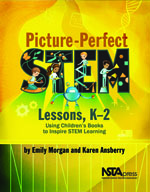 Picture-Perfect STEM Lessons, K-2: Using Children’s Books to Inspire STEM Learning, by Emily Morgan and Karen Ansberry: A guide to integrating science with language arts through picture books that are kid-friendly and engaging. Lessons take students on explorations of books such as Iggy Peck, Architect; The Inventor’s Secret; and Trash to Treasure while they learn to build their own drums, invent a toy car, reduce plastic pollution, and more.
Picture-Perfect STEM Lessons, K-2: Using Children’s Books to Inspire STEM Learning, by Emily Morgan and Karen Ansberry: A guide to integrating science with language arts through picture books that are kid-friendly and engaging. Lessons take students on explorations of books such as Iggy Peck, Architect; The Inventor’s Secret; and Trash to Treasure while they learn to build their own drums, invent a toy car, reduce plastic pollution, and more.
Notable Notebooks: Scientists and Their Writings, by Jessica Fries-Gaither: A trip through time to discover the 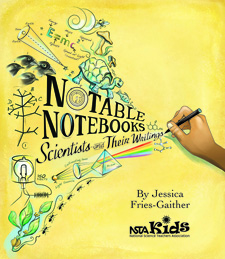 value of a special place to jot your thoughts, whether you’re a famous scientist or a student. This NSTA Kids book brings to life the many ways in which trailblazers from Galileo to Jane Goodall have used a science notebook—to sketch observations, imagine experiments, record data, or write down their thoughts. A 2017 Outstanding Science Trade Book for Students, K–12.
value of a special place to jot your thoughts, whether you’re a famous scientist or a student. This NSTA Kids book brings to life the many ways in which trailblazers from Galileo to Jane Goodall have used a science notebook—to sketch observations, imagine experiments, record data, or write down their thoughts. A 2017 Outstanding Science Trade Book for Students, K–12.
Helping Students Make Sense of the World Using Next 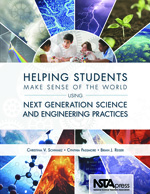 Generation Science and Engineering Practices, edited by Christina Schwarz, Cynthia Passmore, and Brian Reiser: Written in clear, nontechnical language, this book provides real-world examples to show you what’s different about teaching and learning that incorporates science and engineering practices at all grade levels.
Generation Science and Engineering Practices, edited by Christina Schwarz, Cynthia Passmore, and Brian Reiser: Written in clear, nontechnical language, this book provides real-world examples to show you what’s different about teaching and learning that incorporates science and engineering practices at all grade levels.
When the Sun Goes Dark, by Andrew Fraknoi and Dennis Schatz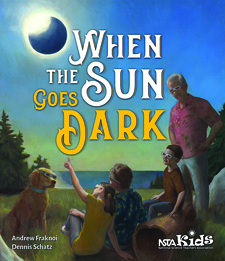 : This illustrated book is a fun way to get young astronomers in grades 5–8 ready for August 2017, when millions of North Americans will have the rare chance to witness a total solar eclipse.
: This illustrated book is a fun way to get young astronomers in grades 5–8 ready for August 2017, when millions of North Americans will have the rare chance to witness a total solar eclipse.
Big Data, Small Devices: 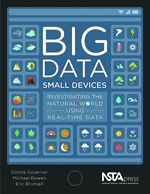 Investigating the Natural World Using Real-Time Data, by Donna Governor, Michael Bowen, and Eric Brunsell: Designed for Earth and environmental science teachers who want to help grades 3–12 students tap into, organize, and deploy large data sets via their devices to investigate the world around them.
Investigating the Natural World Using Real-Time Data, by Donna Governor, Michael Bowen, and Eric Brunsell: Designed for Earth and environmental science teachers who want to help grades 3–12 students tap into, organize, and deploy large data sets via their devices to investigate the world around them.
Argument-Driven Inquiry in Biology: Lab Investigations for Grades 9-12, by Victor Sampson, Patrick Enderle, 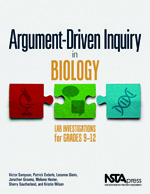 Leeanne Gleim, Jonathon Grooms, Melanie Hester, Sherry Southerland, and Kristin Wilson: A new type of lab investigation that teaches students to use argument to construct, support, and evaluate scientific claims of their own and others. The 27 field-tested labs cover molecules and organisms, ecosystems, heredity, and biological evolution.
Leeanne Gleim, Jonathon Grooms, Melanie Hester, Sherry Southerland, and Kristin Wilson: A new type of lab investigation that teaches students to use argument to construct, support, and evaluate scientific claims of their own and others. The 27 field-tested labs cover molecules and organisms, ecosystems, heredity, and biological evolution.
Argument-Driven Inquiry in Physical Science: Lab Investigations for Grades 6-8, by Jonathon Grooms, 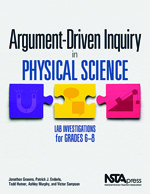 Patrick Enderle, Todd Hutner, Ashley Murphy, and Victor Sampson: Twenty-two engaging labs that will capture students’ interest while they dig into important content and learn scientific practices as the figure out everything from how thermal energy works to what could make an action figure jump higher.
Patrick Enderle, Todd Hutner, Ashley Murphy, and Victor Sampson: Twenty-two engaging labs that will capture students’ interest while they dig into important content and learn scientific practices as the figure out everything from how thermal energy works to what could make an action figure jump higher.
Disciplinary Core Ideas: Reshaping Teaching and Learning, edited by Ravit Golan Duncan, Joseph Krajcik, 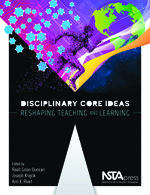 and Ann Rivet: A conceptual tool kit that can help you guide students to see the connections between important science concepts so they can grasp how the world works now—and maybe even make it work better in the future.
and Ann Rivet: A conceptual tool kit that can help you guide students to see the connections between important science concepts so they can grasp how the world works now—and maybe even make it work better in the future.
The BSCS 5E Instructional Model: Creating 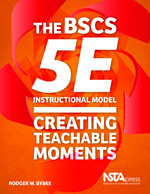 Teachable Moments, by Rodger Bybee: An introduction and roadmap to the widely used 5E Lesson Model of engage, explore, explain, elaborate, and This guidebook will help you structure and sequence lessons so you can experience more teachable moments in your classroom.
Teachable Moments, by Rodger Bybee: An introduction and roadmap to the widely used 5E Lesson Model of engage, explore, explain, elaborate, and This guidebook will help you structure and sequence lessons so you can experience more teachable moments in your classroom.
Uncovering Student Ideas in Earth and Environmental Science: 32 New Formative Assessment Probes, by Page Keeley and Laura Tucker: Engaging formative assessment 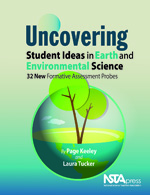 tools can reveal what your students already know (or think they know) about core Earth and environmental science concepts. Armed with those insights, you can use the teacher notes and suggestions to adjust your approach and present the science in grade-appropriate ways to help students build conceptual understanding.
tools can reveal what your students already know (or think they know) about core Earth and environmental science concepts. Armed with those insights, you can use the teacher notes and suggestions to adjust your approach and present the science in grade-appropriate ways to help students build conceptual understanding.
 The NSTA Press Spring 2017 digital catalog highlights all of NSTA’s resources for science teachers K through College.
The NSTA Press Spring 2017 digital catalog highlights all of NSTA’s resources for science teachers K through College.
Disclaimer: The views expressed in this blog post are those of the author(s) and do not necessarily reflect the official position of the National Science Teaching Association (NSTA).


